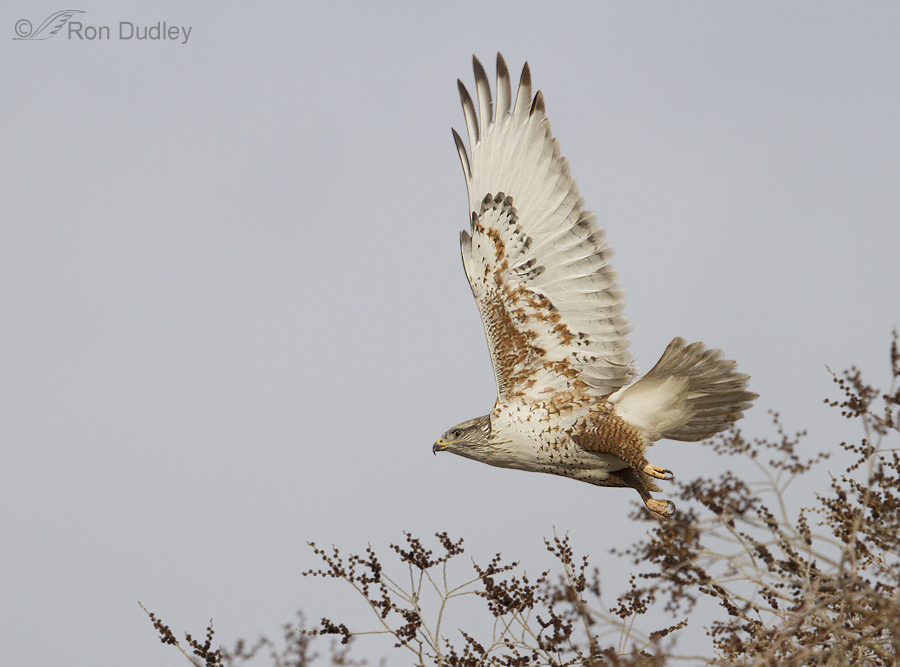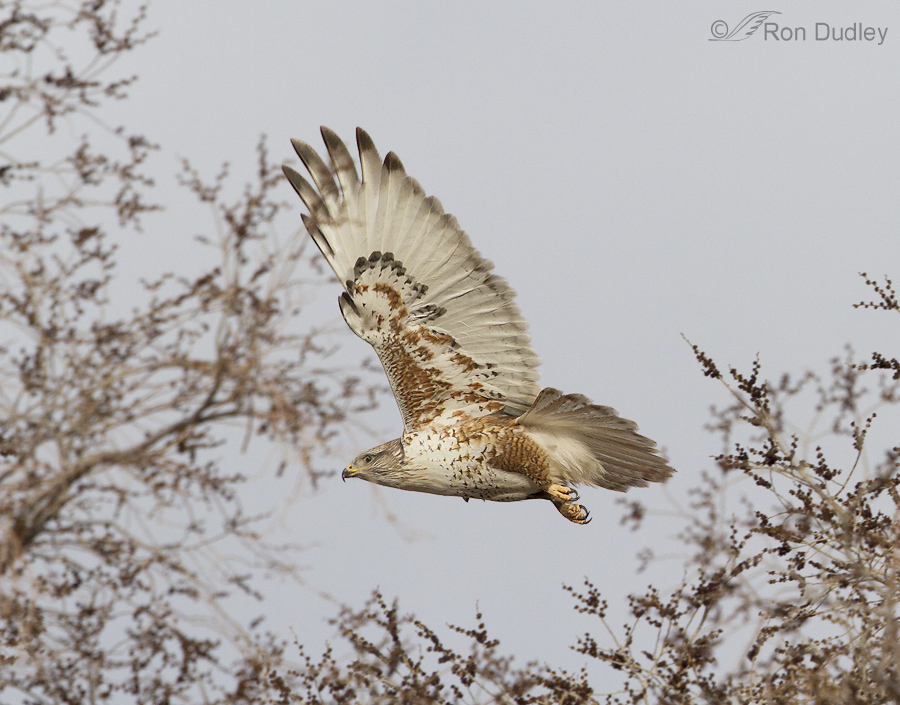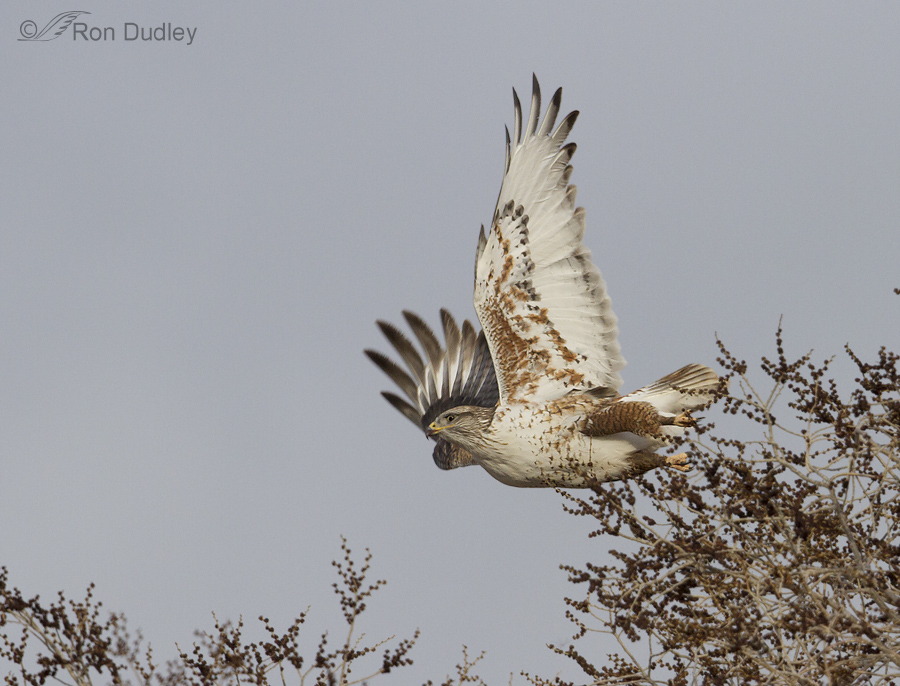The Ferruginous Hawk is often described as “massive and robust” but this one appears to have taken that description to extremes. Weighing up to 4 1/2 lbs (2kg) they are our largest and most powerful buteo so one expects to see an impressive-looking bird but even so I was struck by the prodigious girth of this individual.
1/2000, f/6.3, ISO 640, Canon 7D, 500 f/4 II, not baited, set up or called in
I photographed this hawk last week near Capitol Reef National Park. The bird was almost completely hidden by its tree perch before it took off so I didn’t have high hopes of getting any clear shots as it launched but several of them turned out well enough to reveal its prodigious girth. To my eye it almost looks like a flying tank.

1/2000, f/6.3, ISO 640, Canon 7D, 500 f/4 II, not baited, set up or called in
The hawk still had to fly by/through several more tree branches to come out into the clear so this shot was taken 5 frames after the previous one but the bird obviously hasn’t lost any weight in the interim as its ample “waistline” is still quite evident.

1/2000, f/6.3, ISO 640, Canon 7D, 500 f/4 II, not baited, set up or called in
I think this shot, taken two frames later, reveals the huskiness of the hawk best.
I don’t pretend to be a raptor authority but I’ve observed and photographed many Ferruginous Hawks over the years and I don’t recall having previously seen such a heavy-bodied individual. I’d be interested to know if others with more experience and knowledge of the species think my amateur observation that this bird is unusually rotund is an accurate one. Or not.
All I know for sure is that I wouldn’t want to be a ground squirrel in the crosshairs of this massive hawk.
Ron



I saw one yesterday. I had never heard of the species. I was watching an adult bald eagle fish for trout. It grabbed one, and from out of nowhere this gigantic bird that dwarfed the eagle in size started chasing. I thought it was a golden eagle due to it’s massive size, but the wings were too broad, I had never seen the underwing markings. The two birds flew about 40′ above my head. I was in awe. Not until further research did I find out what the rapto really was. It easily had a 5-6′ wing span and was as agile as the eagle.
I’ve never seen this species so can’t make a comment on its size. All I can do is admire a really beautiful raptor! And the great photograph which shows it so well.
These are beautiful shots of one fat hawk! At least someone benefitted during this long, nasty winter! I’d love to know what her diet was,,,definitely not Weight Watchers, Nutrisystem…. or lo-cal voles! I particularly like the first shot with her head contrasted against her wing(unusual)and the third, just pure beauty…
I am so glad that the poor bird didn’t hear you casting asparagus at its weight. You could give it a complex you know. Not overweight, just under tall.
And how nice to see a bird which very obviously hasn’t had ‘slim pickings’. Thanks Ron.
Good morning . What a fantastic bird .. I haven’t seen one of these in about 12 years .The last one I saw was in my hometown of Bennington, Vt..I sure miss the Green Mts.of Vermont… I look forward to your feathered posts every day..thank you Mr. Dudley
Thanks very much, Gary. Please call me Ron – I haven’t been “Mr. Dudley” since I retired from teaching…
Yes I will..thanks
Amazing shots and bird! Thanks for sharing Ron!
Charlotte
Thank you, Charlotte.
Incredible photos Ron.I know the darker phase Ferruginous Hawk can be sometimes be mistaken for a Golden Eagle ,due to it’s size .
That’s right, John. Some knowledgeable folks have even proposed that Ferrugs be reclassified as eagles!
They were classified as Hawk-Eagles at one point due to the feathered tarsi. That is usually one of the defining traits of eagles and hawk-eagles. I think that Bueteo is the proper classification for them based on their diet, habits, and mannerisms, but I still can’t explain the feathered tarsi.
I’ve only seen two and photographed one. The one I photographed was a bruiser. It was on the ground stalking rodents in their burrows. Its posture was that of a bruiser with a big burly chest, but it did not have the waistline yours does–that’s really something!
Sharon, They’re known for that big chest but I too was impressed by the girth down below of this bird.
Hi Ron, She is a very large adult female, probably on the heavier end of the ones I have seen, but otherwise a typical haggard Feruge. I wish they had bigger feet. Their tiny little feet make them difficult as falconry birds.
Thanks, Mark. I was hoping you might chime in. Yes, their feet do seem small considering the rest of their dimensions.
The one game animal that we have in abundance here in North Eastern Oklahoma is geese. They are universally hated by the wheat farmers and it is easy to get permission to hunt them. The Greater Canada geese are too big a single Harris’ hawk, but a pair or trio can handle them. A golden eagle would be perfect, but the permits to have one are a nightmare. I was hoping that the Feruge would be a good second best, but their tiny little feet make them useless for anything much bigger than cottontails.
Fascinating information, Mark and you explained exactly what I was wondering from your previous comment – why their feet are big enough for them but not for falconers. Thank you.
Great photos that certainly make your point. I don’t think I’ve ever seen a Ferruginous Hawk, so I can’t add to the discussion about the girth of this individual. It is interesting to compare your photos of this husky hawk to ones of cormorants in flight. I think of cormorants as an elongated esophagus with wings.
“I think of cormorants as an elongated esophagus with wings.”
That made me laugh out loud, Dave. Thank you for that!
Beautiful shot, Ron! Great shots of a bird that is so secretive!
Thanks very much, Gail.